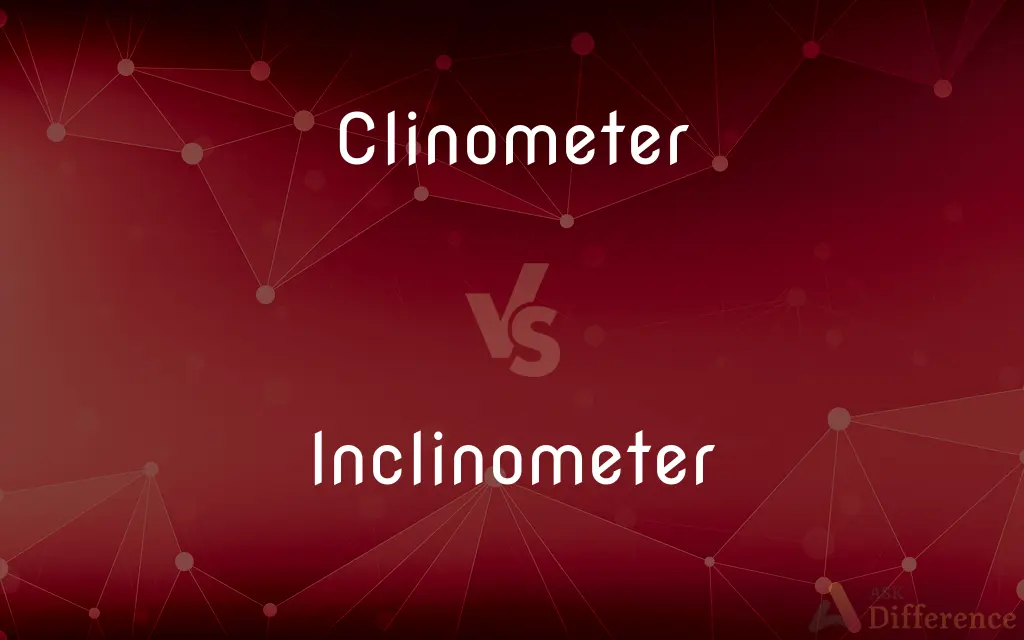Clinometer vs. Inclinometer — What's the Difference?
By Tayyaba Rehman & Maham Liaqat — Updated on March 19, 2024
A clinometer measures angles of inclination, useful in navigation and surveying, while an inclinometer measures slope or tilt in various applications, including engineering and geology.

Difference Between Clinometer and Inclinometer
Table of Contents
ADVERTISEMENT
Key Differences
A clinometer is primarily used to determine the angle of elevation or depression of an object with respect to gravity's direction. This tool is essential in navigation, surveying, and astronomy to measure angles in the vertical plane. On the other hand, an inclinometer, although similar in function, is more commonly applied in engineering, geotechnical studies, and medical fields to measure angles of tilt or slope in structures, landforms, or limbs, indicating their deviation from the horizontal.
Clinometers often feature a sighting tube or telescope for precision in aiming at distant targets to measure angles of elevation or depression accurately. They are widely used in forestry for tree height measurement and in the maritime industry for navigating by celestial bodies. Inclinometers, whereas, might include sensors or fluid-filled tubes to detect angular movement, making them suitable for monitoring the stability of buildings and bridges, assessing landslide risks, and aiding in physical therapy assessments.
Many clinometers are designed for manual operation, requiring direct observation and alignment with the target. These devices may utilize spirit levels, graduated scales, or pendulums to indicate angles. In contrast, inclinometers often incorporate digital technology, offering electronic displays that provide immediate readings, which can be crucial for applications requiring real-time monitoring and precision, such as in the construction of tunnels and for vehicular stability control.
The accuracy and range of measurements can vary significantly between clinometers and inclinometers. Clinometers are typically used for broad measurements and have a wide range of applications that do not require extreme precision. Meanwhile, inclinometers are engineered for higher precision in specific applications, such as geological surveying and structural engineering, where minute changes in angle can be critical.
Clinometers and inclinometers, while both measuring angles relative to gravity, have different scopes of application, reflecting their design and functionality. Clinometers are more generic and versatile for visual angle estimations, ideal for educational and navigational purposes. Inclinometers, on the other hand, offer specialized applications that demand high accuracy and often integrate with other technological systems for comprehensive monitoring and analysis.
ADVERTISEMENT
Comparison Chart
Primary Use
Navigation, surveying, and astronomy
Engineering, geotechnical studies, and medical fields
Measurement Focus
Angle of elevation or depression
Slope or tilt
Common Features
Sighting tube/telescope, spirit levels
Sensors, electronic displays
Applications
Forestry, maritime navigation
Building and bridge stability, landslide risk assessment
Precision
Broad measurements, less precision required
High precision for specific applications
Compare with Definitions
Clinometer
A device for measuring angles of elevation or depression.
The sailor used a clinometer to navigate by the stars.
Inclinometer
Measures tilt or slope, especially in geotechnical applications.
Engineers use inclinometers to monitor landslide-prone areas.
Clinometer
Used in maritime navigation.
Ancient mariners utilized clinometers for celestial navigation on the open sea.
Inclinometer
Monitors slope in tunnel construction.
Inclinometers ensure tunnel segments align correctly during excavation.
Clinometer
Essential in forestry for measuring tree heights.
Foresters use a clinometer to estimate the height of trees for logging.
Inclinometer
Used in structural engineering to assess building tilt.
After the earthquake, inclinometers assessed the building's stability.
Clinometer
Used in surveying to determine slope.
Surveyors rely on clinometers to evaluate land gradients.
Inclinometer
Integral in vehicle stability systems.
Modern cars have inclinometers to enhance safety controls.
Clinometer
Helps in astronomical observations.
Astronomers employ clinometers to align telescopes with celestial objects.
Inclinometer
Aids in physical therapy for measuring limb angles.
Physical therapists use inclinometers to track recovery progress.
Clinometer
Any of various instruments for measuring angles of elevation, slope, or incline, as of an embankment.
Inclinometer
An inclinometer or clinometer is an instrument used for measuring angles of slope (or tilt), elevation, or depression of an object with respect to gravity's direction. It is also known as a tilt indicator, tilt sensor, tilt meter, slope alert, slope gauge, gradient meter, gradiometer, level gauge, level meter, declinometer, and pitch & roll indicator.
Clinometer
An apparatus for measuring a vertical angle, a slope, or the height of a large object (e.g. a tree).
Inclinometer
An instrument used to determine the angle of the earth's magnetic field in respect to the horizontal plane.
Clinometer
An instrument for determining the dip of beds or strata, pr the slope of an embankment or cutting; a kind of plumb level.
Inclinometer
A clinometer, especially one used to indicate the inclination of an aircraft or ship relative to the horizontal.
Clinometer
An instrument used by surveyors in order to measure an angle of inclination or elevation
Inclinometer
An instrument that displays the angle of an aircraft relative to the horizon.
Inclinometer
An instrument that measures magnetic dip; a dip circle.
Inclinometer
A surveying instrument that measures angles of inclination or elevation; a clinometer.
Inclinometer
An instrument showing the angle that an aircraft makes with the horizon
Inclinometer
A measuring instrument for measuring the angle of magnetic dip (as from an airplane)
Inclinometer
An instrument used by surveyors in order to measure an angle of inclination or elevation
Common Curiosities
Can clinometers and inclinometers measure horizontal angles?
Both devices are primarily designed to measure vertical angles, but some inclinometer models can measure horizontal angles as well.
What is a clinometer?
A clinometer is a tool used to measure the angle of elevation or depression of an object with respect to gravity.
How do clinometers and inclinometers differ in application?
Clinometers are broadly used in navigation, surveying, and astronomy, while inclinometers are specialized for engineering, geological studies, and medical applications.
What is an inclinometer?
An inclinometer is a device that measures the tilt or slope of an object, often used in engineering and geotechnical fields.
How do I choose between a clinometer and an inclinometer?
The choice depends on your specific needs: clinometers for general angle measurement and navigation, inclinometers for precision in engineering and medical applications.
Can I use a clinometer for geological surveys?
While a clinometer can be used for basic slope measurements, an inclinometer is preferred for more precise geological surveys.
Are digital inclinometers more accurate than manual clinometers?
Generally, digital inclinometers offer higher precision and are more suited for applications requiring real-time monitoring and high accuracy.
Are inclinometers used in smartphones?
Yes, modern smartphones often include inclinometer functions to detect orientation and motion.
Do inclinometers need calibration?
Yes, to maintain precision, inclinometers often require calibration, especially in professional applications.
What is the typical accuracy range for clinometers?
Clinometer accuracy can vary, but they are generally used for measurements where high precision is not critical.
Can inclinometers monitor building stability over time?
Yes, inclinometers are used to monitor the stability and tilt of buildings, especially after events like earthquakes.
Is a clinometer suitable for educational purposes?
Yes, clinometers are great educational tools for teaching concepts of angles and elevation in various subjects.
How do environmental factors affect inclinometer readings?
Environmental factors like temperature and vibration can affect readings, but many inclinometers are designed to minimize these effects.
Can both devices be used in maritime navigation?
Clinometers are more commonly used in maritime navigation, but inclinometers can also play a role in monitoring ship stability.
What advancements have been made in inclinometer technology?
Advances include digital readouts, wireless data transmission, and integration with other sensing technologies for comprehensive monitoring.
Share Your Discovery

Previous Comparison
Resign vs. Resignee
Next Comparison
Picky vs. ChoosyAuthor Spotlight
Written by
Tayyaba RehmanTayyaba Rehman is a distinguished writer, currently serving as a primary contributor to askdifference.com. As a researcher in semantics and etymology, Tayyaba's passion for the complexity of languages and their distinctions has found a perfect home on the platform. Tayyaba delves into the intricacies of language, distinguishing between commonly confused words and phrases, thereby providing clarity for readers worldwide.
Co-written by
Maham Liaqat













































